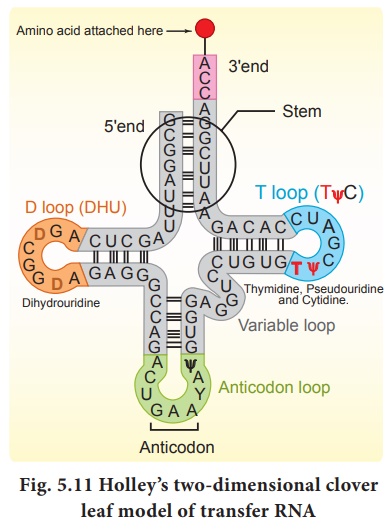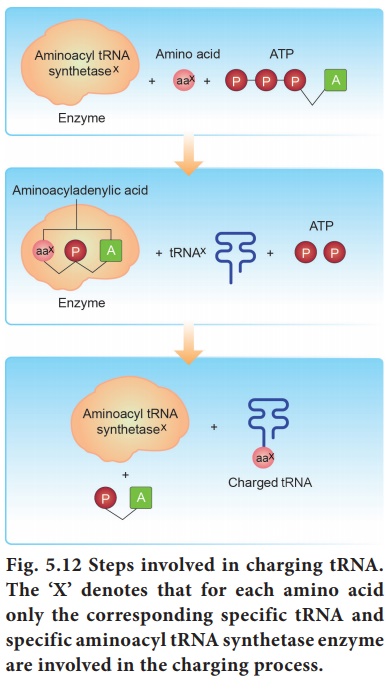Molecular Genetics - tRNA - the adapter molecule | 12th Zoology : Chapter 5 : Molecular Genetics
Chapter: 12th Zoology : Chapter 5 : Molecular Genetics
tRNA - the adapter molecule
tRNA
– the adapter molecule
The transfer RNA, (tRNA)
molecule of a cell acts as a vehicle that picks up the amino acids scattered
through the cytoplasm and also reads specific codes of mRNA molecules. Hence it
is called an adapter molecule. This term was postulated by Francis
Crick.
The two dimensional
clover leaf model of tRNA was proposed by Robert Holley. The secondary
structure of tRNA depicted in Fig. 5.11 looks like a clover leaf.
In actual structure, the tRNA is a compact molecule which looks like an inverted
L . The clover leaf model of tRNA shows the presence of three arms namely
DHU arm, middle arm and TΨC arm. These arms have loops such as amino acyl
binding loop, anticodon loop and ribosomal binding loop at their ends. In
addition it also shows a small lump called variable loop or extra arm. The
amino acid is attached to one end (amino acid acceptor end) and the other end
consists of three anticodon nucleotides. The anticodon pairs with a codon in
mRNA ensuring that the correct amino acid is incorporated into the growing
polypeptide chain. Four different regions of double-stranded RNA are formed
during the folding process. Modified bases are especially common in tRNA.
Wobbling between anticodon and codon allows some tRNA molecules to read more
than one codon.
The process of addition
of amino acid to tRNA is known as aminoacylation or charging and
the resultant product is called aminoacyl- tRNA (charged tRNA). Without
aminoacylation tRNA is known as uncharged tRNA (Fig. 5.12). If two such
tRNAs are brought together peptide bond formation is favoured energetically. Numbers
of amino acids are joined by peptide bonds to form a polypeptide chain. This
aminoacylation is catalyzed by an enzyme aminoacyl – tRNA synthetase.
This is an endothermic reaction and is associated with ATP hydrolysis.
20

The tRNA charged with
amino acid serves as an adapter molecule to decode the information on mRNA.
This is achieved by the interaction of tRNA with mRNA. The tRNA molecule has a
region that contains complementary bases (anticodon) to the codon on the mRNA.
For initiation, there is another specific tRNA that is referred to as initiator
tRNA. There are no tRNAs for stop codons.

Related Topics